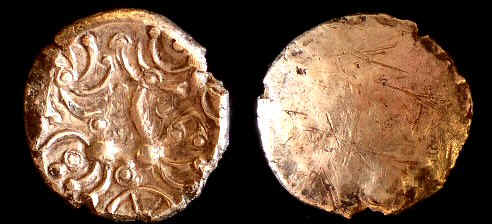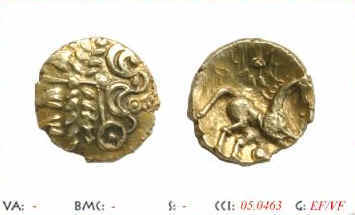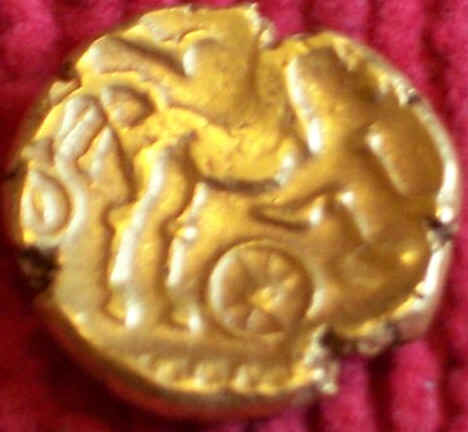

| Type munt | Trinovantes / East Wiltshire sub-tribal group gold stater of the Wonersh / Savernake type | Omschrift voorzijde | Muntconditie | zeer fraai | |
| Provincie | Omschrift keerzijde | Datum | 25 juli 2005 | ||
| Muntplaats | Voorzijde | leaping horse motif with wheel below and sun spiral above | Verkoper | anglo-antiquities | |
| Jaartal | 45-40 bc | Keerzijde | worn dies as usual, traces of wreath pattern etc | Bedrag | GBP 385,00 (EUR 558,41) |
| Vorst | Vindplaats | Veiling | ebay | ||
| Metaal | debased goud | Schatvondst | |||
| Oplage | Literatuur referentie | VA-1522-5 | |||
| Gewicht | |||||
| Diameter | |||||
| Soortelijke massa |

|
CASSIVELLAUNUS WHEEL - You will not see another !!!! Not published
anywhere! Excessively rare North Thames Gold quarter stater possibly of the Cassi tribe and Cassivellaunus himself C. 55 - 50BC. There are only 3 other similar types known to exsist and only in the Celtic Coin Index at Oxford University. This coin has the best known obverse of the 4 known examples and is Trinovantian in style having been found in Hatfield in Herts This coin is stunning and a hughely important find in the Celtic Coin sector. It is was minted in the North Thames area and dated By Dr. Philip de Jersey (CCI Oxford) at between 55 - 50BC it is placed squarely in the areana of Caesar's campaigns of southern Britain in 55 - 54BC . Caesar named five tribes who surrendered to him north of the Thames. The Cemimagni (Iceni of Norfolk), the Segontaicc (possibly south Thames), the Ancalites, the Bibroci and the Cassi. It is thought that the British resistance against Caesar was led by the over-lord Cassivellaunus and it is highly likley that he was the king of the Cassi who would become the Catuvellauni. This stunning coin was minted in the same area and at the same time that Cassivellaunus was active. It is likley that the coin was minted under his rule of the consolidated tribes of the south of England. This unit may have been minted at Verlamio (St Albans) or possible at Braughing. The Coin: 11mm , 1.4g nicley toned yellow gold. Grade EF/VF to central stike. GBP
560,00 (minimumverkoopprijs nog niet gehaald) (EUR 820,83) |
 |
Gold Stater (Trinovantes/Catuvellauni) Rare to find one as good as this. (see pics) VA1520 Weight approx 5.5g Trinovantes/Catuvellauni Tribes (Date and Details) Cunobelin (Cunobelinus) had been king of the Catuvellauni, the most powerful tribe in southern Britain, and the son of Tasciovanus, whose coins bear the name of Verulamium (St. Albans), then the tribal capital. And Tasciovanus probably was the son of Cassivellaunus, who had led the Britons against Caesar during his second invasion in 54 BC. Caesar relates what happened. After several defeats, Cassivellaunus fought a guerrilla action, harassing the Romans until, eventually, the location of his stronghold (oppidium) was betrayed by the Trinovantes, whose own king had been killed by Cassivellaunus and who now allied themselves with Caesar. Cassivellaunus was defeated and was obliged to pay tribute and surrender hostages. He also was forced to give the Trinovantes their independence. Caesar then returned to Gaul. But the Catuvellauni soon reasserted themselves and became the dominant tribe in southeastern Britain. The Trinovantes were able to maintain their independence, however, until the time of Cunobelin, who seized Camulodunum, their capital. Even though the two tribes now became essentially a single kingdom, the Trinovantes again were regarded as a separate tribe by the Romans when the Catuvellauni were defeated by Claudius in AD 43, and, by the time of the Boudican revolt in AD 60, it is the Trinovantes who are driven from their land by the Roman colonists.
|

|
HI - HERE I HAVE FOR SALE A FANTASTIC GOLD STATER IN WHAT I BELIEVE TO BE
BEAUTIFUL CONDITION , DATES FROM 45 - 40 B.C REMIC TYPE , SPINKS CAT NUM 39, I FOUND THIS
GREAT COIN WHILE OUT METAL DETECTING, SEE PHOTOS AND JUDGE ALL FOR YOURSELF , HAPPY
BIDDING , SORRY I DONT NO THE WEIGHT OF THIS COIN AS I HAVE NO SCALES. GBP 205,00 (EUR 300,18), 27-mei-06, ebay, romeo3738 |